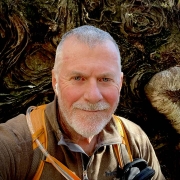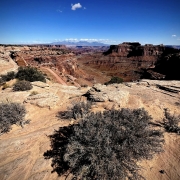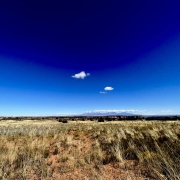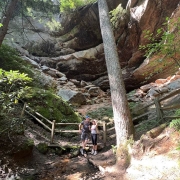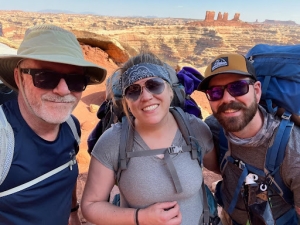Breaking Up With Food: Season Finale | Healthy Aging Series: S9 E24
Beginnings, Middles, and Ends.
What is your favorite season or series finale? Seinfeld? The Office? Breaking Bad?
I love these series and I hated to see them come to an end. I hate endings.
Sometimes I re-watch series and save the season or series finale for maybe a month or two. I did that with the new Star Trek series: Picard. I knew the series was ending, so I watched it in it’s entirely, except for the last three episodes. And then I savored them over the course of six weeks.
One of my Social Work professors, Dr. Timothy Johnson, explained that life, and really therapy, is made up of beginnings, middles, and ends. “You have to attend to each phase,” he would say.
Beginnings: build relationships, introduce new ideas, develop a roadmap.
Middles: revisit the map and goals you have set. Begin the discharge process.
Ends: review progress and develop relapse prevention.
This is the season nine finale, and I wanted to end it with a review, and maybe not relapse prevention, but more looking at excuses for why people fail to break up with food.
First, the Review
I hope I sold you on the idea that you have a relationship with food, and it’s likely that it’s a little dysfunctional.
We looked at ways of determining if it’s dysfunctional.
I discussed the need for breaking up with food and why it’s so difficult.
Throughout this season, I shared four Obesity Memoirs from people who broke up and stayed broke up with food. These were heroic journeys.
I did an interview with Terri, a healthy ager.
I had six episodes that walked you through strategies for breaking up with food.
I finished up the season, providing you with the importance of hope and self-love for breaking up with food
I ended the season with advice for writing a love letter to yourself.
24 episodes.
Ready But Excuses
I was talking about this season with my wife, and she suggested sharing several excuses that keep people from breaking up with food and developing a new lifestyle.
Before I come up with excuses, I want to first say that some people don’t break up with food because they’re not ready. “The lesson begins when the student is ready.”
It usually takes some kind of crisis or life event to break up with food. It could be a lab report. It could be a book. That’s the case with me. 30 years ago my father gave me, “Turning Back the Clock,” by Dr. Bob Arnot. It changed the way I think about fitness.
It could be the loss of a mentor or friend to a preventable disease. It could be that still small voice that you listen to that’s telling you to do something else or you’re going to die.
OK, so let’s assume you’re ready. These are what I call “Ready But Excuses.” You’re ready but….
Ready But Excuse #1
“I don’t have time.” I get home and it’s dark. The mornings are busy getting ready for work and a long commute. My mornings are taken up with kids. I’m exhausted by the weekend, and I just want to relax.
My Advice: Start slow, 30 minutes a day, five days a week. Tag team child rearing with your partner. Alternate resistance training with cardio training. Put exercise on your calendar.
Ready But Excuse #2
“I don’t know how to start.”
Here’s some suggestions:
Join a fitness gym,
Hire a Trainer,
Read books on exercising and nutrition,
Carve out a physical space in your home to workout,
Buy some basic fitness tools. Dumbbells and a bench are a good start.
Ready But Excuse #3
“I don’t enjoy working out.”
My Advice: Try different gyms, classes, groups, activities. I love hiking. It requires almost no skills or equipment. Read episode 21. My wife loves Jazzercise. I cycle during the warmer months. Find something you love. Gyms can be boring.
Ready But Excuse #4
“I’m embarrassed about my appearance and my lack of athleticism.”
Advice: Everyone started there. Everyone was a little embarrassed, not knowing what to do in a gym or being seen walking in the neighborhood.
Here are my thoughts on this excuse: Do you think people are looking at you and thinking, “What a loser!” Nothing could be further from the truth. 99.9% of people who see you are envious because they wish they were working out. Inside they’re saying, “Go girl!”
My second thought is, project yourself out three or six months. You’ll look better, feel stronger, because you started and stayed with it!
Ready But Excuse #5
“I have (fill in the blank) pain.” Your knee. Your hips. Your feet. Your shoulders.
If you’re significantly overweight, your joints are likely suffering from carrying around that extra weight. It may mean you’ll need to focus on the nutrition side of breaking up with food first. You may need to lose 50 to 100 pounds first to take the pressure off your joints. You might need to invest in footwear. I was experiencing Achilles tendon pain. A friend recommended Hokas. Problem solved.
Spend time stretching. The Internet is full of tutorials for stretching.
Ready But Excuse #6
“I hate working out alone.”
Fortunately, there are lots of group-fitness opportunities. Have I mentioned Jazzercize?
Unfortunately, working out can be a little lonely, but use this time to “get into your head.” Some of my most creative times are when I’m hiking alone.
Ready But Excuse #6
“I’ve tried breaking up with food before, but I usually end up making up. I keep going back.”
I get this. Really, think of life as a series of break ups. We will likely need to break up with food again, and again, and again.
What’s wrong with that?
I have wrestled with my relationship with food for 60+ years. I love food! I love get-togethers where there is food! I love eating sugar! And since I have continued to wrestle with food, I’m not 50 pounds overweight. I maintain a mostly healthy weight because I regularly have to break up with food over and over again.
Well, that’s it. Season Nine. I have thoroughly loved studying this topic and writing about it. I hope it helped you have a relationship change with food.

